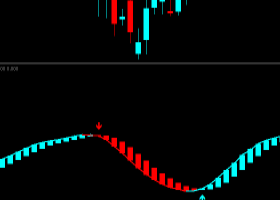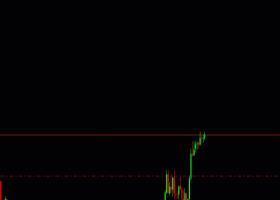Introduction
If you are here, this means that you already know what DrawDown limiter is and you are more interested to understand how it is compliant with the NFA FIFO rule. And If you are not familiar with the DrawDown limiter , it is the best DrawDown limiter you will ever buy. I invite you to check the details on the following blog: https://www.mql5.com/en/blogs/post/752215
Back to our topic, the National Futures Association (NFA) introduced several regulatory measures to enhance transparency and protect the interests of retail forex traders. One such regulation is NFA Compliance Rule 2-43b, also known as the First In, First Out (FIFO) rule. The Rule 2-43b was implemented in 2009. Usually, the brokers in the US follow the FIFO rule. Traders in the United States should also follow this rule. However, traders who aren’t in the US don’t need to follow it because they’re outside the NFA’s jurisdiction. This rule requires forex brokers to execute trades in the order they are received, impacting how traders manage their positions. In this blog, we will delve into the details of the FIFO rule, explore its implications, and, most importantly, explain how DrawDown Limiter respects it.
Explanation and Impact of NFA Compliance Rule 2-43b FIFO Rule
NFA Compliance Rule 2-43b FIFO Rule mandates that the oldest position must be closed first when traders have multiple positions in the same currency pair. This means traders can no longer selectively close positions based on their preferred order. Instead, they must close positions in the exact order they were opened. This rule primarily affects traders who employ hedging strategies or trade multiple positions simultaneously. It restricts their ability to manage positions flexibly and may require adjustments to their trading strategies.
Let's consider a simple example to understand how the FIFO rule works. Suppose a trader opens three positions in USD/JPY:
- Buy Position A of 1 lot on the 1st of November;
- Buy Position B of 1 lot on the 2nd of November;
- and P Buy Position C of 1 lot on the 3rd of November;
In addition to complete position closures, the FIFO rule also applies to partial position closures. Consider a scenario where a trader has a
- Buy Position A USDJPY of 2 lots on the 1st of November;
- Buy Position B USDJPY of 1.5 lots on the 2nd of November;
- Buy Position C USDJPY of 0.25 lots on the 3rd of November;
And here, it comes a little bit tricky because some brokers apply FIFO on the same pair without considering the position size, and some use it on the same pair same size position.
Let us stick to the first case if the trader decides to close only 0.25 lot of the buy positions. According to the FIFO rule, the oldest position must be partially closed first. Therefore, the trader would have to close 0.25 lot from Position A and retain the remaining Position B and C with no modifications, even if they would have preferred to close the sell position partially.
As if we look at the second case, considering "same pair" and "same position size," the trader would have closed Position C and left Positions A and B with no modifications.
Most brokers follow the second rule, which provides retail traders a kind of workaround and flexibility by always opening different size positions.
In conclusion, NFA Compliance Rule 2-43b FIFO Rule has introduced a significant change in forex trading by requiring traders to close positions in the order they were opened. This regulation impacts traders who engage in hedging or maintain multiple positions simultaneously. By understanding and adhering to the FIFO rule, traders can ensure compliance with NFA regulations and adjust their trading strategies accordingly. Forex traders need to stay updated with the latest regulatory changes to navigate the dynamic landscape of the forex market successfully. And it is essential that you fall under NFA's jurisdiction to make sure to ask your broker how this rule is applied so you can adjust your trading strategy accordingly.
Official text of NFA Compliance Rule 2-43b FIFO Rule can be found under: https://www.nfa.futures.org/rulebooksql/rules.aspx?Section=4&RuleID=RULE%202-43
How does DrawDown Limiter Respect the rule?
DrawDown limiter is there to protect your account. And it acts with four different triggers to automatically close your open positions to protect your account from drawdown. When closing your trades, DrawDown Limiter needs to respect this rule to avoid leaving you behind positions not closed and accounts not protected.
The triggers are:
- When current range drawdown is reached
- When open position positions, floating profit is reached inside the end-of-day security zone
- When the maximum number of simultaneously open positions is reached
- When the maximum number of open and closed positions is reached
For the first two points, if you are under NFA jurisdiction or not, the DrawDown limiter is acting to close all your open positions in the first in first out order, so there is no risk here as we are closing everything. However, the trigger (3) and (4) will require you to instruct the DrawDown limiter on what rule to follow when an extra trade is open beyond the limit you defined for simultaneously open positions and max number of range positions. Three options are available, and we will go through those via some examples:
(1) No FIFO rule to apply: Any extra position, without consideration to the size or pair of the open positions, the new position will be automatically closed. In the example below, five positions are opened, and any new new positions is automatically closed by DrawDown Limiter. Therefore, the new SELL and BUY orders on BTC were closed, and no FIFO was applied.
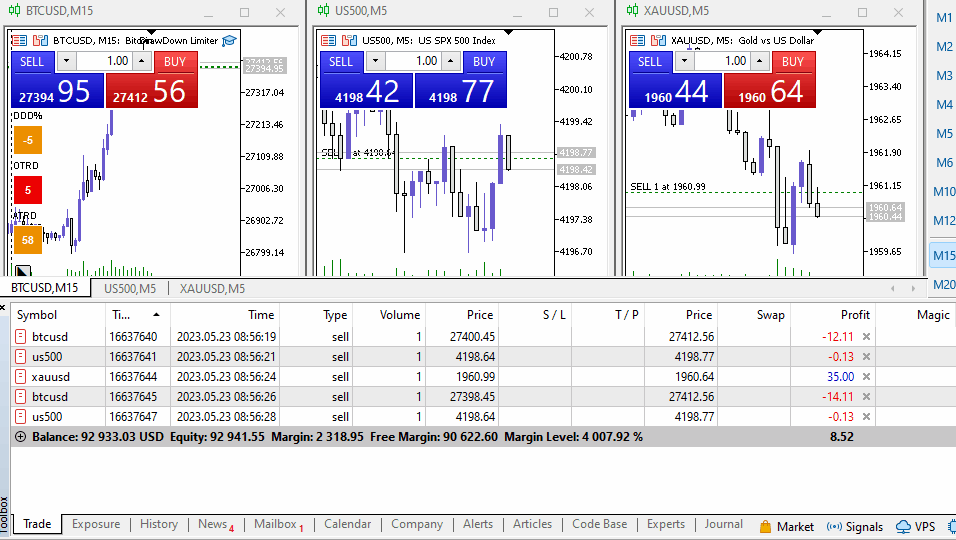
(2) FIFO rule to apply on same positions with same pair and same size only: In this case, any extra position opened DrawDown Limiter will check if a matching position with the same pair and same size exists, if it is the case, the old position is first closed. If there are no matching criteria, the last opened position will be closed. In the example below, five positions are opened. The oldest is #16637640, a SELL position of 1 lot on BTCUSD. When the user opens a new SELL on BTCUSD of 1 lot, position #16637685, the DrawDown limiter respects FIFO and closes the oldest position. However, when the user tries to SELL 2 Lots on BTCUSD, and as we don't have previous positions of 2 LOTS on BTCUSD, this last position is automatically closed.
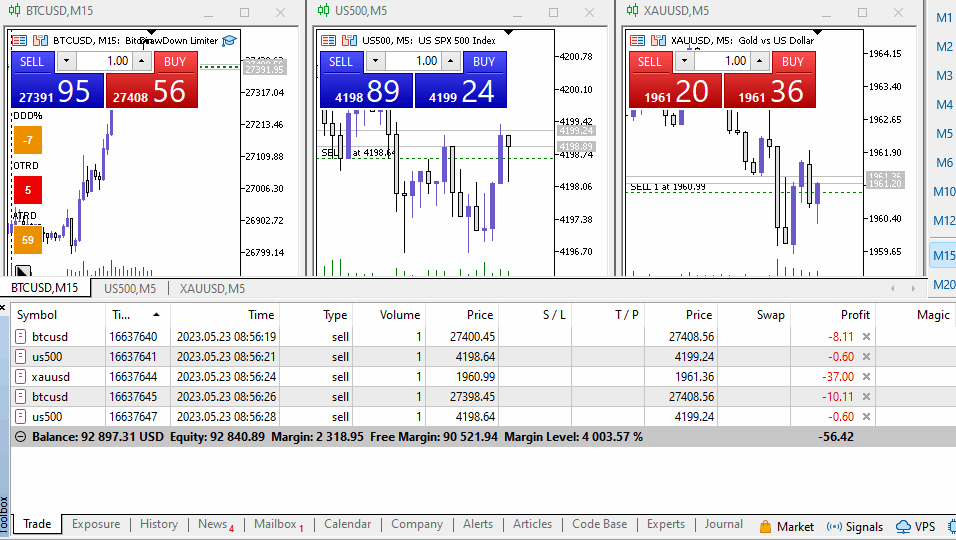
(3) FIFO rule to apply on same pair and activating partials: In this case any extra position opened, DrawDown Limiter needs to close it but as it respect FIFO, it will check if positions with same pair are older. If it is the case, DrawDown Limiter will do total or partial close of positions from the oldest to the newest in order to maintain the same volume on a given pair. If the new position is on a new pair, it will be closed automatically. In the example below, 5 positions are opened. When the user is trying to open a SELL of 1 lot in BTCUSD, DrawDown Limiter will be closing an oldest position on BTCUSD with the same volume. However, if the user tries to sell 0.5 lots on BTCUSD, DrawDown limiter will close an equivalent volume from an older position, so it partially closes a previous sell on BTCUSD. And when the user tries to sell 2.5 lots, DrawDown limiter will work on closing an equivalent to 2.5 lots, so totally closed the three previous trades of 0.5, 1, and 0.5 lots, and partially close 0.5 lots from the newest position.
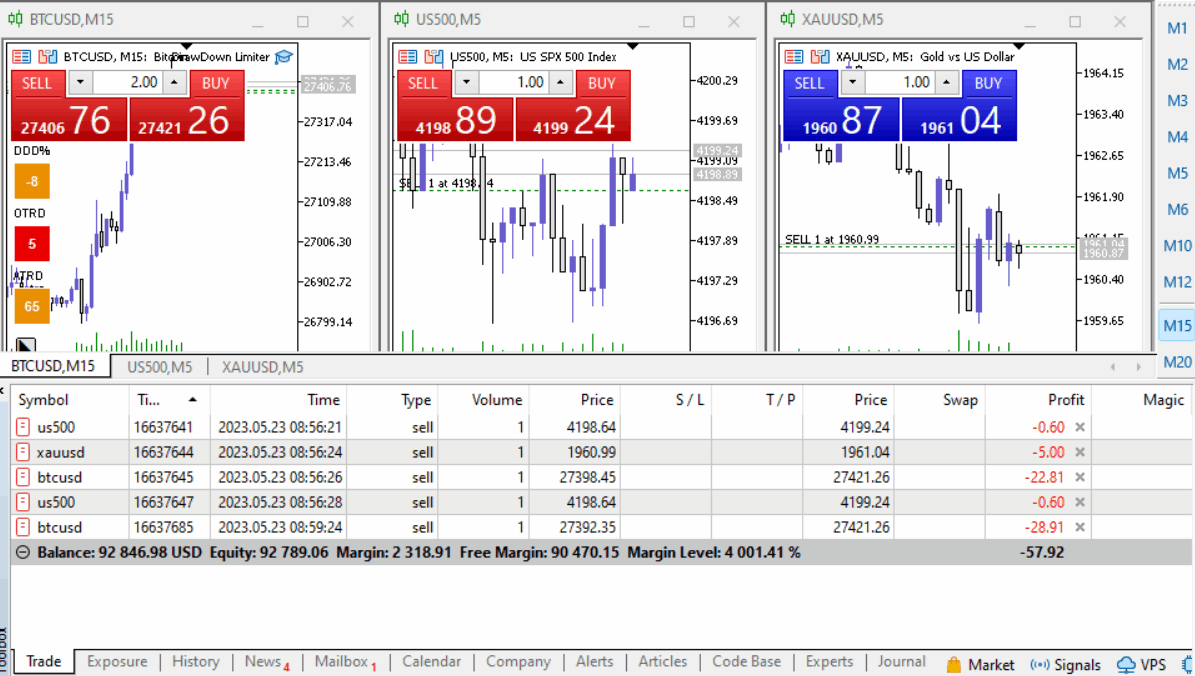
Need help or have questions? I am Lio, don't hesitate to reach out! We are always available to respond, help, and improve. Our support channel is always here for you

